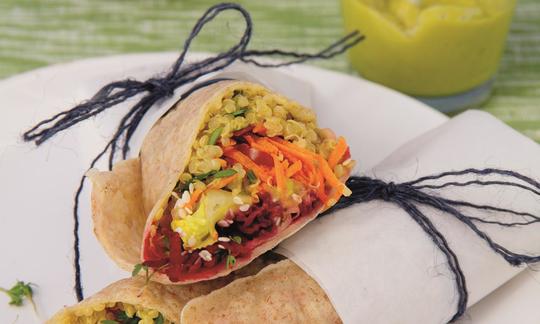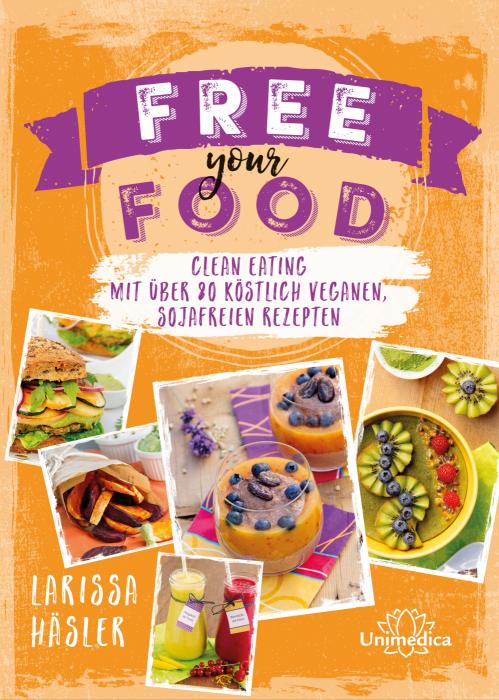Colorful Energy Wraps with Quinoa and Beets
vegan
Ingredients (for servings, )
Equipment
- hand-held blender / immersion blender or blender
- grater
- vegetable peeler
- whisk
- skillet (frying pan)
- stove
- citrus juicer (lemon squeezer)
- saucepan
- salad spinner
Type of preparation
- cook
- fry
- chop or grind
- blend
- squeeze
- cool
- meld
- season to taste
- purée
- peel
- grate (shred)
- drain
Preparation
Making the batter for the wraps
Combine both types of flour in a mixing bowl. Add the salt, baking powder, and water and then blend the ingredients together with a wire whisk until the batter is smooth. Let the batter rest for 15 minutes.For the quinoa
In the meantime, rinse the quinoa and add it to a saucepan along with lightly salted water using a ratio of 2 parts water to 1 part quinoa. Bring to a boil, reduce the heat, and simmer for 20 minutes. Remove the saucepan from the heat and let the cooked quinoa cool. Chop the parsley and mix into the quinoa.The original recipe called for 80 g of quinoa for two servings. We have reduced this amount by half as we feel this is sufficient.
For the avocado sauce
Combine the avocado, mango, and lemon juice and then purée. Finely chop the chili peppers and stir into the avocado sauce along with the cumin. Season with salt and pepper. Stir half of the sauce into the quinoa and season well.We have reduced the sauce ingredients listed in the original recipe (for two servings) by half.
For the filling
Wash and spin the lettuce. Wash and finely chop the tomatoes. Peel, cut in half, and finely shred the beets. Grate the carrots.The author recommends using butterhead lettuce, arugula, or lamb’s lettuce.
Preparing the wraps
For each wrap, heat a little coconut oil in a skillet. Pour a soup ladle full of batter into the skillet and then tip and rotate the skillet until the bottom is coated with batter. Cook the wrap for three minutes, and then flip and cook on the other side for an additional two minutes. Sprinkle occasionally with a little water while it is cooking. Continue this process with the remaining batter.This recipe makes enough batter for four wraps. The original recipe lists two teaspoons of coconut oil. We have deliberately reduced the amount of oil, but the amount you will need to use so that the batter doesn’t burn depends on the type of skillet you are using. If you are using a nonstick skillet, you may not need any oil at all.
Serving
Layer the quinoa, lettuce, tomatoes, shredded beets, and grated carrots in the middle of the wraps. Finish with the avocado sauce, sesame seeds, and cress. Roll up the wraps, cut in half, and enjoy.
|
Nutritional Information per person
Convert per 100g
|
2000 kcal | |
|---|---|---|
| Energy | 537 kcal | 26.9% |
| Fat/Lipids | 13 g | 19.3% |
| Saturated Fats | 3.4 g | 17.2% |
| Carbohydrates (inc.dietary fiber) | 93 g | 34.6% |
| Sugars | 19 g | 21.4% |
| Fiber | 15 g | 61.0% |
| Protein/Albumin | 18 g | 35.9% |
| Cooking Salt (Na:380.2 mg) | 966 mg | 40.2% |
| Essential micronutrients with the highest proportions | per person | 2000 kcal | |
|---|---|---|---|
| Vit | Vitamin K | 494 µg | 659.0% |
| Vit | Vitamin B9, B11 (Folate, as the active form of folic acid) | 287 µg | 144.0% |
| Min | Manganese, Mn | 2.7 mg | 133.0% |
| Vit | Vitamin C (ascorbic acid) | 103 mg | 129.0% |
| Vit | Vitamin A, as RAE | 893 µg | 112.0% |
| Elem | Potassium, K | 1'690 mg | 85.0% |
| Min | Copper, Cu | 0.74 mg | 74.0% |
| Prot | Tryptophan (Trp, W) | 0.17 g | 70.0% |
| Prot | Threonine (Thr, T, irreversibly transaminated) | 0.58 g | 62.0% |
| Vit | Vitamin B6 (pyridoxine) | 0.83 mg | 59.0% |
Detailed Nutritional Information per Person for this Recipe
The majority of the nutritional information comes from the USDA (US Department of Agriculture). This means that the information for natural products is often incomplete or only given within broader categories, whereas in most cases products made from these have more complete information displayed.
If we take flaxseed, for example, the important essential amino acid ALA (omega-3) is only included in an overarching category whereas for flaxseed oil ALA is listed specifically. In time, we will be able to change this, but it will require a lot of work. An “i” appears behind ingredients that have been adjusted and an explanation appears when you hover over this symbol.
For Erb Muesli, the original calculations resulted in 48 % of the daily requirement of ALA — but with the correction, we see that the muesli actually covers >100 % of the necessary recommendation for the omega-3 fatty acid ALA. Our goal is to eventually be able to compare the nutritional value of our recipes with those that are used in conventional western lifestyles.
| Essential fatty acids | per person | 2000 kcal |
|---|---|---|
| Linoleic acid; LA; 18:2 omega-6 | 2.4 g | 24.0% |
| Alpha-Linolenic acid; ALA; 18:3 omega-3 | 0.24 g | 12.0% |
| Essential amino acids | per person | 2000 kcal |
|---|---|---|
| Tryptophan (Trp, W) | 0.17 g | 70.0% |
| Threonine (Thr, T, irreversibly transaminated) | 0.58 g | 62.0% |
| Isoleucine (Ile, I) | 0.59 g | 48.0% |
| Phenylalanine (Phe, F) | 0.70 g | 45.0% |
| Valin (Val, V) | 0.69 g | 43.0% |
| Leucine (Leu, L) | 1.00 g | 41.0% |
| Lysine (Lys, K, irreversibly transaminated) | 0.57 g | 31.0% |
| Methionine (Met, M) | 0.24 g | 26.0% |
| Vitamins | per person | 2000 kcal |
|---|---|---|
| Vitamin K | 494 µg | 659.0% |
| Vitamin B9, B11 (Folate, as the active form of folic acid) | 287 µg | 144.0% |
| Vitamin C (ascorbic acid) | 103 mg | 129.0% |
| Vitamin A, as RAE | 893 µg | 112.0% |
| Vitamin B6 (pyridoxine) | 0.83 mg | 59.0% |
| Vitamin B1 (Thiamine) | 0.54 mg | 49.0% |
| Vitamin B3 (Niacin) | 6.4 mg | 40.0% |
| Vitamin B5 (Pantothenic acid) | 2.3 mg | 39.0% |
| Vitamin B2 (Riboflavin) | 0.48 mg | 34.0% |
| Vitamin E, as a-TEs | 3.7 mg | 31.0% |
| Vitamin B7 (Biotin, ex vitamin H) | 10 µg | 20.0% |
| Essential macroelements (macronutrients) | per person | 2000 kcal |
|---|---|---|
| Potassium, K | 1'690 mg | 85.0% |
| Phosphorus, P | 366 mg | 52.0% |
| Sodium, Na | 380 mg | 48.0% |
| Magnesium, Mg | 166 mg | 44.0% |
| Calcium, Ca | 196 mg | 25.0% |
| Essential trace elements (micronutrients) | per person | 2000 kcal |
|---|---|---|
| Manganese, Mn | 2.7 mg | 133.0% |
| Copper, Cu | 0.74 mg | 74.0% |
| Iron, Fe | 6.8 mg | 49.0% |
| Zinc, Zn | 3.4 mg | 34.0% |
| Selenium, Se | 3.3 µg | 6.0% |
| Fluorine, F | 137 µg | 4.0% |
| Iod, I (Jod, J) | 3.3 µg | 2.0% |
Narayana Verlag GmbH /Unimedica Verlag , Larissa Häsler
Raw recipes 31, Cooked recipes 52 (3)
Additional photos (8)
In "Free your Food" you learn how to prepare vegan dishes using plant-based, unprocessed ingredients, without additives or soy products.
Since this book is written in German, a description is omitted here. If you are interested, please switch to German in the menu.
These colorful wraps are healthy and satisfying. They contain avocado and carrots along with quinoa and beets.
Quinoa: Quinoa is a pseudograin with a slightly nutty flavor that can be eaten either raw or cooked. It originated in the South American Andes, where it has been used for over 6,000 years. Quinoa is gluten-free and contains more protein, magnesium, and iron than the other common types of grains. It also contains all of the essential amino acids, including lysine!
Spelt flour: Spelt flour is closely related to wheat and is often referred to as “proto-wheat.” Both whole grain and white spelt flour are available in stores. While all types of spelt flour are a good source of minerals, whole grain spelt flour has a higher nutrient content and is a healthier choice. White spelt flour (type 630) is mainly used for baking and in most recipes can be used as a substitute for wheat flour. The nutrient content of spelt is comparable to that of wheat, with the exception of silica. Spelt flour contains significantly higher levels of this nutrient than does wheat flour.
Red beets: Red beets are particularly well known for their deep red color which comes from the high concentration of the glycoside betanin, a compound in the betalain class of pigments. They can be eaten raw, cooked, or pickled. Beets are rich in Vitamin B, potassium, and iron, and are an exceptionally good source of folic acid. The nitrates in beets can reduce blood pressure. While eating large amounts of red beets can cause the urine or stool to turn red, this is a temporary and harmless side effect. Red beets contain high levels of oxalic acid, which is why individuals who are at risk for developing kidney stones, such as Crohn’s disease patients, should avoid eating large amounts of the vegetable.
Avocados: Avocados have a high fat content, and thanks to the creamy consistency of the pulp are also known as “butter fruit.” They have a higher fat content than all other types of fruits and vegetables, and are rich in potassium and unsaturated fatty acids. Avocados are best eaten raw, so long as the flesh has not turned grayish or brown.
Purchasing avocados: Avocados purchased at the grocery store are usually still too hard to eat. However, it’s fine to buy them in this state because they will continue to ripen. When the fruit is firm yet yields to gentle pressure, you will know that they are ready to eat The stem area should be easy to remove when an avocado is fully ripe. Avoid fruit with dark blemishes on the skin or over-soft fruit since these are often bruises which indicate that the avocado inside will have brown spots.
Beets and stains: Beet juice stains easily, so it is a good idea to wear gloves when preparing beets. Dishes and kitchen equipment should be soaked or washed immediately after use.
To decrease preparation time: To save time, continue working on other preparation steps when you reach a point where you need to wait, for instance when you are finished preparing the batter or while the quinoa is cooking.
Gluten-free wraps: You can make gluten-free wraps by using a combination of equal parts buckwheat flour and cornmeal. Here is a suggested recipe for 2 servings:
80 g cornmeal, 80 g buckwheat flour, 200–250 ml water, a pinch of salt.
Lettuce: As noted in the original recipe, you can also use butterhead lettuce, lamb’s lettuce, or any other type of lettuce, including combinations.
Fresh chili: Instead of chili flakes, you can also use fresh chili peppers. We recommend half of a chili pepper for two servings. But of course there is no limit to how spicy you can make it.




